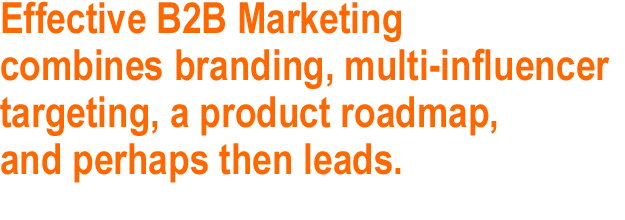

Scott Jamieson is CEO of Annex Business Media, Canada’s largest B2B media, events and market services company. He is a 30+ year veteran of the B2B media and marketing space. For the past 15 years he has also helped buy a lot of stuff as part of a $1.5M+ annual tech budget, gaining insight into the complex SMB buying journey along away.
 Read the original Harvard Review article, here.
Read the original Harvard Review article, here.
 Learn more about Bain & Co., who have a Canadian footprint, here.
Learn more about Bain & Co., who have a Canadian footprint, here.
 Discover the markets Annex Business Media serves, here.
Discover the markets Annex Business Media serves, here.
 Check out the absolute best rice pilaf recipe, here.
Check out the absolute best rice pilaf recipe, here.
Want to reach out to swap stories and experiences? Fill out the form below!

Detailed research from Bain & Co. highlights why you need to be on the radar long before the lead stage, the need to reach beyond the C-suite, and the importance of a solid roadmap for where your products or services are headed. Frankly, our own experience supports that. And if you read to the very end, I guarantee that you will not leave empty handed.
I have first-hand experience at how B2B stuff gets bought
For example, the company I manage runs sophisticated data base software that keeps well over one million audience, prospect and client records in actionable, CASL-compliant form. This tech stack includes a unified database, customer data platform and marketing automation. It’s a sizable investment for us, costing north of $500,000 per year from one vendor. When we chose our current partner, Chicago-based Omeda, we followed a very deliberate, considered and longish process to select it. In the end, the buying team and our vendor partner aced it, and four years into this relationship we haven’t looked back.
I share this because our process for that major buy ($2M and counting), and several smaller ones since, perfectly reflects the B2B buying process illustrated by some recent research from Bain & Co. They received survey results from over 1,200 B2B buyers and performed in-depth interviews with 10 of them. Their results are also very similar to those found in a 2017 Canadian B2B buyers’ survey done by industry association Magazines Canada that had over 7,000 respondents. But never mind the research – If you’ve been a part of a significant B2B purchase decision lately, you’ll see some familiar trends.
If on the other hand you sell to B2B buyers like me and my teams, get your notebook out. Here are a few of the points gleaned from an excellent Harvard Business Review article on the Bain study and notes from the Canadian counterpart. I’ve included some personal action items from someone on the frontlines of both B2B marketing and B2B buying.

Make the first cut, or forget it
Depending on what item folks are buying, 80% to 90% of B2B purchasers start the project off with a pre-set list of vendors, prior to doing any fresh research. Ask yourself – Where did they get that list?
More urgently, 90% ultimately choose a vendor partner from that original list. The Canadian study also found that a large majority of B2B buyers greatly prefer to do business with a brand they recognize.
For example, we learned about our current database vendor from a few industry publications and conferences, as well as their participation in some events. When their current president reached out to meet me, they had long been at the top of our list. I was awaiting his call.
Action Item:
Keep your lead gen programs by all means, but what are you doing for demand gen, or what we used to call branding? When a buyer starts the selection process, how can you ensure you make that initial list? Do they even know you have the solution? When was the last time they were reminded of that? This is where investments in branding, content marketing and thought leadership pay off.

Be where the buyers are
The quality of your own website is crucial – be sure it’s fast and navigable. But buyers will also turn to other sources. This includes colleagues, industry publications, and webinars/conferences.
In our case, we worked the full gamut when choosing our vendor – Their websites (some were really bad, and we moved on quickly); case studies based on our industry colleagues; B2B media in the space and their conferences; and webinars. Only then did we reach out to our short list.
Action Item:
Support and be visible at industry events, even if in moderate ways. Buyers like me notice. Partner with established trade media brands. That may mean sponsoring a webinar on an adjacent topic (but not with a hard sell approach) or content marketing to inform. Most modern B2B media brands can offer the full spectrum from omni-channel branding through events and webinars, content creation and marketing and lead gen when it’s time. And given the importance of colleague referrals, think testimonials and case studies.
Bonus hint: The vendor we chose was active in all these areas.

Show the future
In choosing our current tech partner, a key focus was on their future roadmap. We had a 5-year vision for where our business was headed and the technology we needed to get there. Did they have a map, and were they aligned? Surprisingly, some did not really have one, or could not convey it.
It turns out that this is a common desire among B2B buyers. Bain & Co. found that we want to know where you’re taking your product or service next. Just remember we’ll also hold you to it.
Action Item:
Build that roadmap with your people, formalize it in your marketing and sales tools, and ensure your customer-facing teams know it. Work with existing clients and prospects in refining it over time. And under-promise. Focus some of your marketing efforts on thought leadership, either via webinars or content marketing. That may mean helping your technical leaders become thought leaders.

Forget the C-suite
Okay, that’s a bit harsh, as we undoubtedly play a key role in vendor selection for investments beyond a certain investment threshold. But we find many B2B marketers obsess over the C-suite at the expense of all else. Trust me – we’re not that hands-on.
Bain & Co. found that most meaningful B2B buying starts with creating an internal committee, with each member holding various levels of influence. The core buying committee that recommends the product after review has the most influence, while the senior or “ultimate decision maker” relies on their research and hands-on expertise.
That will sound familiar to people involved in investments at our company. The Canadian research found that for projects with a total value of $250K or more, this group typically involved five or more decision makers, plus the final nod.
Action Item:
Reaching committee members at the project manager or director level is not possible with an overly defined audience. Target beyond the C-suite with a varied array of marketing collateral and channels, like ROl-based case studies, industry case studies and testimonials.
For instance, in extensive research into our nine construction brands in 2021, a third-party survey company found that younger managers loved webinars and virtual events, and other digital assets (as they have no travel budget), while senior “decision makers” preferred in-person meetings and print materials. Finally, ensure you have more than the senior person in demos and needs-analysis conversations.
I know that this complexity is unwelcome, and means giving up on the simple “we need leads” conversation many of us on the revenue side have. But if you think about how buying decisions get made at real-world SMBs like yours and mine, we all need to embrace the complexity.
